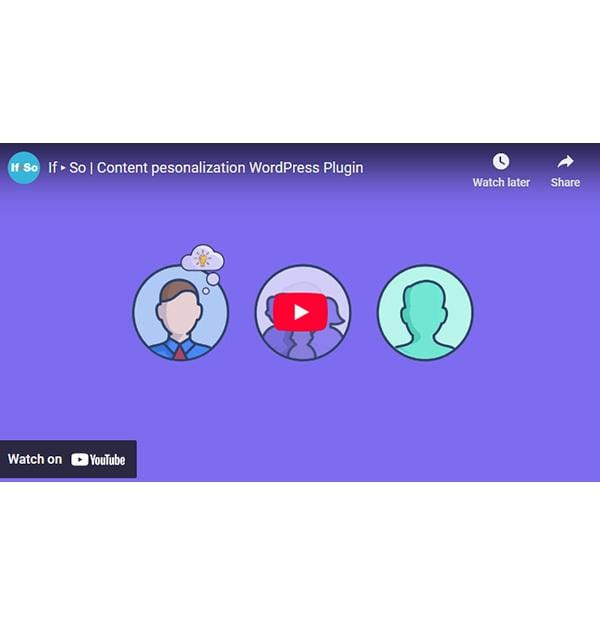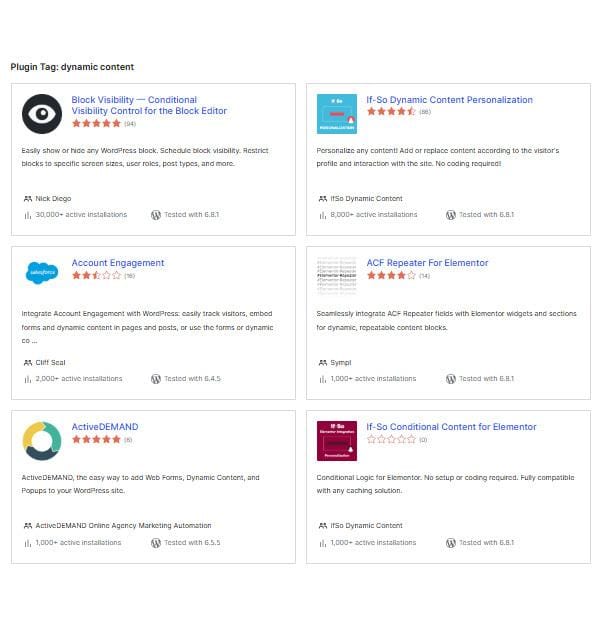In the current digital era, delivering bland, one-size-fits-all content just doesn’t impress anyone anymore. Today’s consumers want websites to recognize their needs immediately and provide personalized, relevant experiences as soon as they arrive.
Content personalization WordPress solutions have emerged as game-changers, allowing businesses to create dynamic, engaging experiences that speak directly to individual users.
With 71% of consumers expecting personalized content from brands, user personalization on WordPress has become a business essential rather than just an added feature. Whether you operate a small business blog or oversee a large enterprise website, delivering tailored content can greatly boost your site’s performance and enhance user satisfaction.
Understanding Content Personalization in WordPress
Content personalization involves dynamically adjusting website content based on user data, behaviors, and preferences.
Rather than showing identical content to every visitor, personalized WordPress sites adapt their messaging, offers, and recommendations to match individual user characteristics and interests.

Source: WordPress
This approach works by collecting and analyzing various data points, including geographic location, browsing history, device type, referral source, and user behavior patterns. The system then uses this information to display content that’s most relevant to each specific visitor, creating a more engaging and effective user experience.
Modern WordPress user experience optimization through personalization can range from simple location-based messaging to sophisticated behavioral targeting that adapts content based on previous interactions and purchase history.
The Business Impact of WordPress Personalization
The numbers speak volumes about the effectiveness of personalized content strategies. Research consistently shows that personalization most often drives a 10 to 15 percent revenue lift, with company-specific improvements spanning 5 to 25 percent, depending on sector and execution capability. These aren’t marginal gains. They represent substantial business improvements that directly impact the bottom line.
Key Performance Improvements
WordPress user personalization delivers measurable improvements across multiple business metrics:
- Reduced bounce rates as visitors find more relevant content
- Increased time on site through engaging, targeted experiences
- Higher conversion rates from better-matched offers and messaging
- Improved customer loyalty through more satisfying user experiences
- Enhanced lead generation quality and quantity
- More effective cross-selling and upselling opportunities
Competitive Advantage Benefits
The strategic value of targeted content delivery becomes even more pronounced when considering market dynamics:
- Many businesses still rely on outdated one-size-fits-all approaches
- Personalized experiences create clear differentiation in crowded markets
- Early adopters gain sustainable competitive advantages over slower-moving competitors
- Customer expectations continue rising, making personalization increasingly essential for market relevance
By investing in personalization, companies create distinctive experiences that strengthen customer relationships and fuel sustainable business growth.
Core Personalization Strategies for WordPress
Geographic and Demographic Targeting
Location-based personalization represents one of the most accessible entry points for WordPress sites. This strategy involves displaying content, offers, and messaging tailored to visitors’ geographic locations. For example, an ecommerce site can show region-specific shipping information, local store locations, or weather-appropriate product recommendations.
Demographic targeting extends this concept by considering factors like age group, industry, or company size for B2B sites. This approach enables businesses to speak directly to different audience segments with messaging that resonates with their specific circumstances and needs.
Behavioral Personalization
Behavioral targeting leverages user actions and browsing patterns to determine content relevance. This sophisticated approach tracks pages visited, time spent on different sections, download behavior, and interaction patterns to build user profiles that inform content decisions.
WordPress sites can implement behavioral personalization through various methods, including showing related content based on reading history, displaying products similar to previously viewed items, or adjusting call-to-action messaging based on engagement levels.
Return Visitor Recognition
Distinguishing between new and returning visitors enables targeted messaging for different stages of the customer journey.
New visitors might see introductory content, company overviews, or welcome offers, while returning visitors could receive updates on new products, loyalty rewards, or personalized recommendations based on their previous interactions.
This strategy acknowledges that users have different information needs depending on their familiarity with your brand and helps guide them toward appropriate next steps.
Essential WordPress Personalization Tools and Plugins
Dynamic Content Plugins
Several WordPress plugins specialize in delivering personalized content experiences.
If-So Dynamic Content allows you to create conditional content blocks that display different information based on user characteristics like location, referral source, or browsing history.

Source: WordPress
Logic Hop provides similar functionality with additional features for behavioral targeting and advanced segmentation. These tools enable non-technical users to implement sophisticated personalization without custom development.
Analytics and Testing Solutions
WordPress user experience optimization requires ongoing measurement and refinement. Plugins like Jetpack offer built-in analytics that track personalization performance, while specialized tools provide A/B testing optimization capabilities to optimize content variations.
Effective personalization strategies rely on continuous testing and improvement, making analytics integration essential for long-term success.
Marketing Automation Integration
Advanced WordPress personalization often involves connecting with external marketing automation platforms. These integrations enable more sophisticated segmentation based on CRM data, email engagement history, and cross-channel behavior patterns.
Such connections allow WordPress sites to leverage comprehensive customer profiles for highly targeted content delivery.
Effective Implementation Strategies
Successful WordPress user personalization requires strategic planning and thoughtful execution. Following proven best practices ensures your personalization efforts deliver maximum value while avoiding common implementation mistakes.
Start with Clear Objectives
Effective personalization begins with well-defined goals that guide every strategic decision:
- Define specific metrics: conversion rates, engagement levels, or customer satisfaction scores
- Establish baseline measurements to track improvement over time
- Align personalization goals with broader business objectives
Begin with simple personalization tactics before advancing to complex strategies. Geographic targeting or return visitor recognition provides immediate value while allowing teams to build expertise and demonstrate ROI before investing in sophisticated behavioral targeting systems.
Prioritize Data Privacy and Transparency
Modern personalization must balance effectiveness with privacy considerations to maintain user trust:
- Implement transparent data collection practices with clear privacy policies
- Provide easy opt-out mechanisms for users who prefer generic experiences
- Ensure compliance with GDPR, CCPA, and other relevant privacy regulations
- Communicate the value users receive in exchange for their data
Building trust through responsible data handling creates the foundation for sustainable personalization programs that users willingly engage with rather than viewing as intrusive.
Focus on User Value
The most effective targeted content delivery strategies prioritize user benefit over aggressive sales tactics:
- Make websites more helpful, relevant, and efficient for visitors
- Eliminate friction from the customer journey through smart content placement
- Provide genuine value rather than simply demonstrating data collection capabilities
- Test personalization elements to ensure they improve rather than complicate user experience
Measuring Personalization Success
WordPress user experience optimization requires systematic measurement and analysis. Key metrics include conversion rate improvements, engagement increases, time on site changes, and bounce rate reductions.
Advanced analytics should track personalization effectiveness across different user segments and content types. This data informs optimization decisions and helps identify the most impactful personalization strategies for your specific audience.
Regular testing and refinement ensure personalization strategies continue delivering value as user behaviors and preferences evolve.
Advanced Personalization Techniques
AI-Powered Content Recommendations
Sophisticated WordPress sites can leverage artificial intelligence to automatically generate content recommendations based on user behavior patterns.
These systems analyze browsing history, content engagement, and user characteristics to suggest relevant articles, products, or resources.
Machine learning algorithms continuously improve recommendation accuracy by learning from user interactions and feedback.
Dynamic Email Integration
Connecting WordPress personalization with email marketing creates cohesive cross-channel experiences. Users might receive personalized newsletters based on their website activity, or see email content reflected in their next site visit.
This integration ensures consistent messaging and maximizes the impact of personalization efforts across multiple touchpoints.
Common Pitfalls and How to Overcome Them
WordPress user personalization implementations can face several challenges that undermine effectiveness. Understanding these common mistakes helps businesses avoid costly missteps and create more successful personalized experiences.
Over-Personalization Issues
- Creating creepy or intrusive experiences that damage user trust
- Demonstrating excessive data collection rather than providing value
Solution: Focus on helpful, relevant content that genuinely improves the user experience
Technical Implementation Problems
- Inconsistent experiences across different devices or user sessions
- Personalization features that break or malfunction under certain conditions
Solution: Conduct thorough testing across various scenarios and user journeys to ensure reliability
Insufficient Data Foundation
- Attempting advanced targeting without adequate user information
- Making assumptions based on limited behavioral data
Solution: Build robust data collection processes before implementing sophisticated personalization strategies
The Future of WordPress Personalization
Content personalization WordPress solutions continue evolving with advancing technology and changing user expectations. Artificial intelligence integration will enable more sophisticated automated personalization, while privacy-focused approaches will emphasize transparent, user-controlled customization.
Voice interfaces, mobile-first experiences, and cross-device continuity will shape future personalization strategies. WordPress sites that invest in flexible, scalable personalization foundations will be best positioned to adapt to these emerging trends.
The integration of real-time data processing and predictive analytics will enable even more responsive and anticipatory user experiences that exceed current personalization capabilities.
Final Thoughts
Content personalization WordPress strategies represent a fundamental shift in how businesses approach digital experiences. The data makes it clear that targeted content delivery is no longer just a passing trend; it’s become an essential component of successful WordPress user experience optimization that directly impacts revenue and customer satisfaction.
The journey toward effective WordPress user personalization doesn’t require massive technical investments or complex implementations.
Small businesses can start with simple geographic targeting or behavioral triggers, while enterprises can leverage sophisticated AI-driven solutions.
The key lies in understanding your audience and gradually building more sophisticated personalization capabilities.
As privacy regulations evolve and user expectations continue rising, businesses that master personalization now will have significant competitive advantages. The investment in creating relevant, dynamic experiences pays compound returns through improved engagement, higher conversions, and stronger customer loyalty.
The future belongs to websites that treat visitors as individuals rather than anonymous traffic. WordPress personalization tools make this level of customization accessible to organizations of every size, democratizing what was once only available to tech giants.
Author Bio
Andy Beohar is the Managing Partner at SevenAtoms, a premier San Francisco-based ecommerce marketing agency. SevenAtoms excels at helping SaaS, Tech, and Ecommerce businesses achieve exceptional growth through paid search and paid social campaigns. Andy strategizes and executes high-impact paid search marketing strategies that drive measurable results. Connect with Andy on LinkedIn or Twitter!









